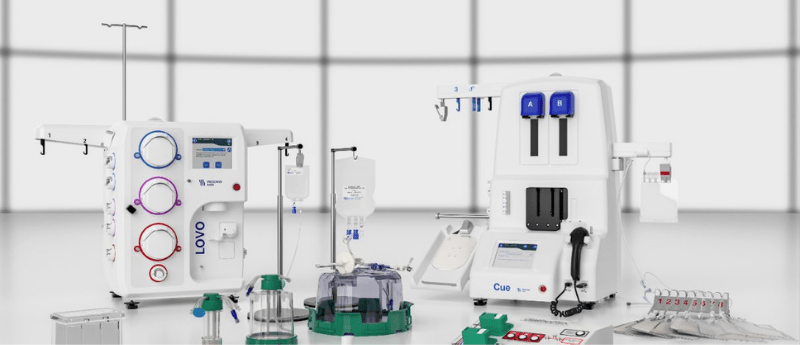Achieving a scalable, cost-effective and practical manufacturing platform for CGTs: an interview with Josh Ludwig

 In this interview, Josh Ludwig (ScaleReady, MN, USA) describes how a scalable, cost-effective and practical manufacturing platform for cell and gene therapies (CGTs) might be achieved. In addition to this, we hear more about what critical factors can help to ensure the successful commercialization of these therapies, including how automation and robotic manufacturing systems could help with scale-up and product quality.
In this interview, Josh Ludwig (ScaleReady, MN, USA) describes how a scalable, cost-effective and practical manufacturing platform for cell and gene therapies (CGTs) might be achieved. In addition to this, we hear more about what critical factors can help to ensure the successful commercialization of these therapies, including how automation and robotic manufacturing systems could help with scale-up and product quality.
Josh Ludwig is the Commercial Director for North America at ScaleReady, where he works closely with hundreds of groups to help them create optimized cell production protocols for CGT. Josh has more than a decade of experience working in the biotech industry, with a focus on CGT for more than 7 years and served as the Director of Technical Support at Wilson Wolf (MN, USA), the manufacturer of the G-Rex closed-system bioreactor. At ScaleReady, he brings his unique perspective and experience working with the G-Rex to help companies at all stages of cell therapy development to focus on manufacturing simplicity and cost efficiency.
Can you tell us more about ScaleReady and the company’s mission?
ScaleReady is a joint venture between Bio-Techne (MN, USA), Fresenius Kabi (Bad Homburg, Germany) and Wilson Wolf (MN, USA) that brings together industry leaders with a shared purpose. Our founding partners have a proven history of innovation in CGT and a joint commitment to advancing the industry. Our combined resources, expertise and experience position us to make a meaningful contribution to the industry – now and in the future.
ScaleReady provides proven tools and technologies for intelligent and intentional cell therapy manufacturing. Our platform addresses the longstanding need for a truly scalable, cost-effective and practical manufacturing platform.
How can a scalable, cost-effective and practical manufacturing platform for CGTs be achieved?
The industry has long been misled by the conventional wisdom limiting media height for static cell culture. This was largely due to the tools available at the time – namely T-flasks and standard media bags. As a result, overly complex instrumentation was developed to mix, perfuse and maintain optimal cell culture conditions. However, this approach forfeits scalability for automation and lacks practicality when scaling out for larger patient populations.
We’ve broken through the conventional barriers with revolutionary products that eliminate the need for complex instrumentation and constant culture monitoring. Our solutions, specifically the G-Rex, allow cells to obtain the exact amount of nutrients and oxygen they want when they want it. As simple as it sounds, we’ve put a lot of thought into the design because we want it to be scalable, cost-effective and practical for manufacturing. The industry shouldn’t have to make tradeoffs between automation and scalability. A manufacturing process should provide flexibility to grow or shrink with ease according to market needs.
To further that point, using a platform that accommodates multiple-unit operations and scales linearly is paramount to success and cost minimization. A process that linearly scales means rapid process development can occur at a small scale, resulting in transduction and expansion protocols that will predictably scale up and out. The transparency of linear models enables clear modeling and visibility of scaling requirements needed to meet future patient populations.
It is also important to consider the space and capital investment required if the therapy becomes first or second line, where patient populations increase. This is why the practicality of the manufacturing platform is critical. We believe current integrated and automated systems do not accommodate the high level of patient output we know is coming for cell therapies. Flexible platforms that support high-volume parallel processing are the solution to the need today and into the future.
In your opinion, what critical factors can help to ensure the successful commercialization of these therapies?
It is crucial that cell therapy organizations build a manufacturing process that can accommodate patient populations once a therapy is proven successful. Meaning – choose a process that can practically grow or shrink based on patient need without placing stress on production infrastructure and capital investments. They must keep their process open to alternate manufacturing paths that facilitate high-throughput parallel processing of patient material. One such alternative is optimizing and automating individual unit operations. This method enables closed systems operations to be connected with flexibility.
We also believe efficient and cost-effective parallel patient processing can only be accomplished using centralized incubation during cell expansion. Systems with integrated incubation bottleneck output by tying up critical unit operation programs for days while cells incubate. Solutions, such as the G-Rex, are a conduit for the centralized incubation approach. They have a small footprint but result in better cell expansion compared to the integrated systems. Also, cell transduction, activation and expansion can be performed in a single, closed system, escalating cell therapy processing throughputs.
How might automation and robotic manufacturing systems help with scale-up and product quality when it comes to CGTs?
Automation and robotics are necessary and inevitable for CGTs, especially in manufacturing. Nevertheless, with any new technology, there are learning curves to overcome. A potential problem with jumping too quickly into full automation or robotics is that current options constrain processing throughput, which ultimately limits patient access and hinders reductions in overall manufacturing costs.
In order to maximize efficiency and maintain scale-out flexibility, it is crucial to automate processes within individual unit operations as the first step. Linking these optimized and automated unit operations can help the field achieve a more cost-effective process that accommodates the appropriate patient population size.
What more needs to be done to make CGTs a scalable and viable solution for patients?
First and foremost, cost management throughout the entire manufacturing process will be critical as it relates to patient access and healthcare coverage. The costs can be managed by thinking ahead, and perhaps outside the box, to determine the most intelligent process for scaling a cell therapy up and out. For example, early partnerships with raw material suppliers can ensure material cost, security and quality – all of which will lower manufacturing risks and improve process scale-up and patient output. Intelligently scaling up also means minimizing and managing highly skilled personnel practically. Improving a process for simplicity can certainly help with that. For example, the G-Rex bioreactor, by design alone, eliminates unnecessary process interventions. This drives down process complexity, increases its repeatability and reduces the need for skilled personnel.
Lastly, what advancements in cell therapy manufacturing does ScaleReady hope to see in the next 5–10 years from now?
Within the next 5–10 years, we hope to see CGT accommodate larger patient sizes and, in turn, save more lives. For that to come to fruition, we expect the industry to move toward CAR and TCR therapies as frontline therapeutics for patients. As we’ve discussed, we’ll need more viable manufacturing strategies to be adopted in tandem. We also need to expand the scope of cancers or ailments we can treat using CGT. Academic and industry R&D teams are actively pursuing new strategies and targets to do just this. We expect scientific advances toward targeting solid tumors to be one of the first to come online.
From a manufacturing perspective, we should expect to see a more supportive and prepared raw material infrastructure. Groups, such as Bio-Techne, are establishing dedicated facilities that aren’t reactive but are proactive to supply raw materials like proteins at scale for the future.
Disclaimer
The opinions expressed in this interview are those of the interviewee and do not necessarily reflect the views of RegMedNet or Future Science Group.
In association with:






